Save money with 'the fall clothes rotation'
Loading...
Late last winter and early last spring, many local places put their fall and winter clothes on deep discount. Long sleeved shirts and long pants had to go to make room for the short sleeved shirts and shorter pants, after all.
I actually went to one of these sales and picked up a couple of items on deep discount. I took those items home, opened up a box that I keep in the garage, and added the items to that box.
That box, of course, contained my fall and winter clothes.
Just a few days ago, I pulled out that box. When I opened the lid, I found a bunch of folded, clean clothes that were appropriate for the season.
Over the next few weeks, as I wash them and fold them, I’ll be adding most of my spring and summer clothes to that box. Soon, that box will find itself out in the garage, waiting on a shelf for April.
* * *
The fall (and spring) clothes rotation is such a simple move, but it saves me quite a lot of money.
Whenever I notice that an article of clothing is getting worn out, I just add it to the rag bag. I don’t worry about replacing it immediately.
Instead, at the end of the season, when clothes are on deep discount as the styles for the next season are rotating in, I might buy enough items to make up for the ones I had to get rid of (if I didn’t already find them elsewhere). Those items are almost always purchased at a very steep discount.
I put those discounted items away with my other seasonal clothes and open up the box of clothes I have stored for the coming season. On top of that box, I’ll find a few new items of clothing – the ones I bought on sale several months ago when they were being rotated out – and underneath it I have a full wardrobe of clothes for the coming season.
Thanks to this rotation, I simply don’t spend much for clothes, yet I have nice, presentable, and seasonally appropriate clothes for every season.
* * *
Obviously, this type of clothes rotation works best where the late fall and winter weather is drastically different than the spring and summer weather. However, you can still approximate this advantage in other areas.
The real key to my clothes plan is to have a “cap” on my wardrobe size. I only have a certain number of winter clothes and a certain number of summer clothes. When a new item is added, it’s either there to take up a slot or it’s in waiting to take up a slot (and the latter only happens when I receive a clothes gift).
If you’re in a place that doesn’t have seasonal rotation, just have a single wardrobe with a “cap” and then wait for sales in your area. Whenever those sales pop up – sales tax holidays, inventory rotations for other purposes – get on board and buy a few items, but don’t add them to your wardrobe until you’re directly replacing something else that’s worn out.
In other words, buy clothes based on low prices, not based on need or want.
It’s a simple change from how I used to buy clothes, where I’d just add new stuff whenever it seemed appropriate. The financial difference, though, is immense.






